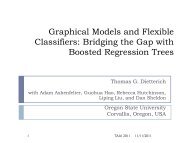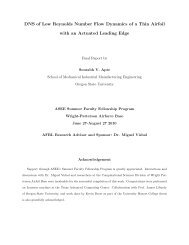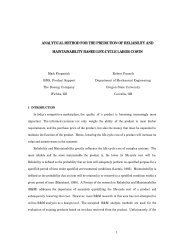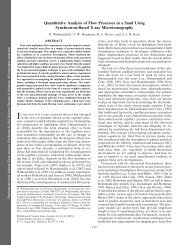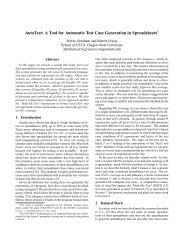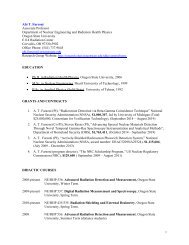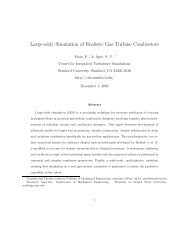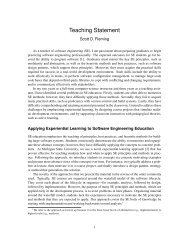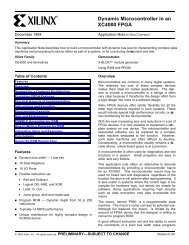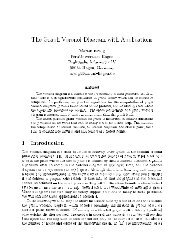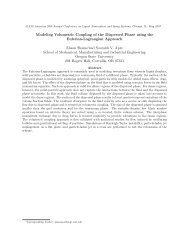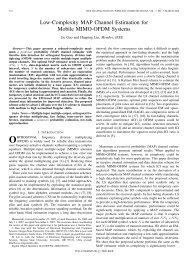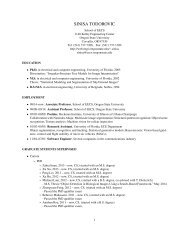Visualization of Diversity in Large Multivariate Data Sets
Visualization of Diversity in Large Multivariate Data Sets
Visualization of Diversity in Large Multivariate Data Sets
You also want an ePaper? Increase the reach of your titles
YUMPU automatically turns print PDFs into web optimized ePapers that Google loves.
1054 IEEE TRANSACTIONS ON VISUALIZATION AND COMPUTER GRAPHICS, VOL. 16, NO. 6, NOVEMBER/DECEMBER 2010design for a formal user study <strong>in</strong>tended to understand the effectiveness<strong>of</strong> a visual representation <strong>in</strong> communicat<strong>in</strong>g diversity <strong>in</strong>formation. Weevaluate the <strong>Diversity</strong> Map by us<strong>in</strong>g this study design to compare itto Pearlman et al.’s visualization [25], the only other representationspecifically designed to visualize diversity. In compar<strong>in</strong>g user performancebetween Pearlman et al.’s representation and the <strong>Diversity</strong>Map, we show that users can consistently and as or more accuratelyjudge elements <strong>of</strong> diversity us<strong>in</strong>g the <strong>Diversity</strong> Map.The rest <strong>of</strong> this paper is organized as follows. We beg<strong>in</strong> <strong>in</strong> Section2 with a precise def<strong>in</strong>ition <strong>of</strong> diversity derived from the def<strong>in</strong>ition<strong>of</strong> species diversity used by ecologists, and we lay out a set <strong>of</strong> requirementsfor diversity visualizations based on this def<strong>in</strong>ition. Wethen discuss related work <strong>in</strong> Section 3 <strong>in</strong> the context <strong>of</strong> the presenteddef<strong>in</strong>ition and requirements. In Section 4, we present and discuss the<strong>Diversity</strong> Map representation <strong>in</strong> the context <strong>of</strong> what is known about humanperception. In Section 5, we describe a formal study designed tounderstand the effectiveness <strong>of</strong> a visual representation <strong>in</strong> communicat<strong>in</strong>gdiversity <strong>in</strong>formation, and <strong>in</strong> Section 6, we evaluate the <strong>Diversity</strong>Map representation us<strong>in</strong>g this study design. F<strong>in</strong>ally, we discuss themerits and shortcom<strong>in</strong>gs <strong>of</strong> the <strong>Diversity</strong> Map representation, suggestdirections for future work, and draw our conclusions.2 DEFINING DIVERSITYBefore discuss<strong>in</strong>g its visualization further, we must first establish amore thorough def<strong>in</strong>ition <strong>of</strong> diversity. With this <strong>in</strong> place, the requirementsfor a successful diversity visualization will become more clear.The data sets <strong>in</strong> which we are <strong>in</strong>terested represent samples <strong>of</strong> populations<strong>of</strong> objects (e.g. students, moths, stocks, etc.) that are describedby multiple variables, or attributes (e.g. GPA, ethnicity, gender, etc.).To def<strong>in</strong>e the diversity <strong>of</strong> such a set, we borrow from the establishedfield <strong>of</strong> Ecology, where biological diversity is def<strong>in</strong>ed as “the varietyand abundance <strong>of</strong> species <strong>in</strong> a def<strong>in</strong>ed unit <strong>of</strong> study” [23].Two measures <strong>of</strong> diversity are used <strong>in</strong> Ecology: richness, which issimply the number <strong>of</strong> species <strong>in</strong> the unit <strong>of</strong> study represented out <strong>of</strong>all possible species; and evenness, which describes the variability <strong>in</strong>species abundances [23]. Generaliz<strong>in</strong>g from Ecology, we say that apopulation sample is diverse with respect to a specific attribute if itexhibits a rich variety <strong>of</strong> values <strong>of</strong> that attribute and if each <strong>of</strong> thosevalues is evenly abundant. In other words, high diversity correspondsto a uniform distribution <strong>of</strong> objects across all possible values <strong>of</strong> an attribute.We extend the def<strong>in</strong>ition <strong>of</strong> diversity to sets <strong>of</strong> arbitrary objectsdescribed by many different attributes by simply def<strong>in</strong><strong>in</strong>g overall diversityas the aggregated diversity over all attributes be<strong>in</strong>g considered.As an example <strong>of</strong> how this def<strong>in</strong>ition is applied, consider analyz<strong>in</strong>gthe diversity <strong>of</strong> a university’s potential <strong>in</strong>com<strong>in</strong>g freshman class. Inparticular, if we are consider<strong>in</strong>g the diversity <strong>of</strong> different populations<strong>of</strong> applicants with respect to their <strong>in</strong>come levels, then a very diversepopulation will conta<strong>in</strong> a similar number <strong>of</strong> applicants (i.e. even abundances)<strong>in</strong> each <strong>of</strong> many possible <strong>in</strong>come brackets (i.e. a rich variety).In contrast, a very non-diverse population might conta<strong>in</strong> applicants <strong>in</strong>only a s<strong>in</strong>gle <strong>in</strong>come bracket (i.e. no variety) or mostly applicants <strong>in</strong>a s<strong>in</strong>gle <strong>in</strong>come bracket with very few applicants <strong>in</strong> each <strong>of</strong> the others(i.e. very uneven abundances). The diversity <strong>of</strong> other attributes, suchas GPA, ethnicity, gender, etc., would also contribute to the overalldiversity <strong>of</strong> a particular population <strong>of</strong> applicants.Beyond our def<strong>in</strong>ition <strong>of</strong> diversity, we also borrow several conventionsfrom the study <strong>of</strong> biodiversity. Specifically, we adopt <strong>in</strong>dividualobjects as our unit <strong>of</strong> measure, and, as <strong>in</strong> the study <strong>of</strong> biodiversity, wetreat all possible values <strong>of</strong> an attribute and all <strong>in</strong>dividuals <strong>in</strong> a populationsample as equal. Additionally, s<strong>in</strong>ce we have extended thedef<strong>in</strong>ition to account for diversity over many attributes, we adopt theadded convention that all attributes are treated as equal.In order to adequately convey diversity as def<strong>in</strong>ed above, a visualizationshould possess the follow<strong>in</strong>g properties:• Communicates the attributes <strong>of</strong> <strong>in</strong>terest, the richness <strong>in</strong> variety<strong>of</strong> the values <strong>of</strong> each attribute, and the evenness <strong>of</strong> abundance <strong>of</strong>the population sample <strong>of</strong> <strong>in</strong>terest over the values <strong>of</strong> each attributewhile consider<strong>in</strong>g all attributes and objects equally.• Scales well to large multivariate data sets, i.e. ones conta<strong>in</strong><strong>in</strong>gmany objects (> 1000) and many attributes (> 5).• Enables users to make judgments about diversity with little effortthrough an efficient perceptual encod<strong>in</strong>g (while ideally, the visualizationshould be designed so that the user perceives diversitypreattentively, i.e. without focused attention [35], we understandthat this is difficult for large attribute spaces).3 RELATED WORKIn this section, we review a subset <strong>of</strong> exist<strong>in</strong>g multivariate visualizationtechniques, emphasiz<strong>in</strong>g those that apply to the problem <strong>of</strong> explor<strong>in</strong>gthe diversity <strong>of</strong> a set <strong>of</strong> objects, as def<strong>in</strong>ed earlier. We focusonly on representation methods and organize our review based on thetaxonomy proposed by Keim et al. [16].3.1 Standard 2D/3D DisplaysTechniques such as scatter plots, box plots, bar charts, and histogramseffectively support tasks such as f<strong>in</strong>d<strong>in</strong>g outliers, gaps, clusters, andcorrelations over a small number <strong>of</strong> attributes [29]. However, whilethe box plot is well suited to display<strong>in</strong>g evenness <strong>of</strong> abundance, it fails<strong>in</strong> communicat<strong>in</strong>g richness <strong>of</strong> variety and is not applicable to categoricaldata. Likewise, without additional encod<strong>in</strong>g, the scatter plotmay lead to ambiguous communication <strong>of</strong> evenness <strong>of</strong> abundance dueto occlusions caused by data overlap. A rectangular heatmap can beviewed as a special case <strong>of</strong> the scatter plot where a value is plotted forevery comb<strong>in</strong>ation <strong>of</strong> the two mapped attribute values and a po<strong>in</strong>t isreplaced by a colored square. Like the scatter plot, heatmaps are limitedto display<strong>in</strong>g diversity over only the two attributes be<strong>in</strong>g mapped.However, occlusion is no longer a problem. The histogram, <strong>in</strong> particular,is well suited to show<strong>in</strong>g richness <strong>in</strong> variety and the evenness <strong>of</strong>distribution <strong>of</strong> objects over a s<strong>in</strong>gle attribute. As noted, all <strong>of</strong> theseapproaches typically display only one or two attributes <strong>of</strong> <strong>in</strong>terest.The use <strong>of</strong> small multiples may solve some <strong>of</strong> these problems. Forexample, scatter plot matrices may provide useful representations <strong>of</strong>diversity, especially for high and low diversity cases, but <strong>in</strong>termediatevalues may be difficult to disambiguate due to data overlap. While jitter<strong>in</strong>gtechniques may help alleviate this problem, they may give themislead<strong>in</strong>g appearance <strong>of</strong> evenness when it is not actually present. Amatrix <strong>of</strong> heatmaps would avoid the data overlap issue and could bean <strong>in</strong>terest<strong>in</strong>g approach to view<strong>in</strong>g diversity (both richness and evenness).Small multiples <strong>in</strong> matrix form, however, require screen spacethat grows with the square <strong>of</strong> the number <strong>of</strong> attributes. Small multiples<strong>of</strong> histograms could be a powerful method for diversity visualization,s<strong>in</strong>ce these appear capable <strong>of</strong> convey<strong>in</strong>g both richness <strong>of</strong> variety andevenness <strong>of</strong> abundance. However, it is not clear how well overall diversityis communicated by multiple spatially separated histograms.The <strong>Diversity</strong> Map representation, described <strong>in</strong> Section 4, is <strong>in</strong> fact asmall multiple histogram representation with an alternative encod<strong>in</strong>gthat facilitates communication <strong>of</strong> overall diversity.Alternatively, rank/abundance—or Whittaker—plots [37] are commonlyused by ecologists to visualize species abundance distribution.The representation is a variation <strong>of</strong> the scatter plot <strong>in</strong> which species areranked from most to least abundant and then plotted along the x axis,while the y axis shows the relative abundance <strong>of</strong> species. The shape<strong>of</strong> the result<strong>in</strong>g curve provides <strong>in</strong>sight <strong>in</strong>to species evenness (or dom<strong>in</strong>ance).Although this approach is specific to species abundance, it andthe other standard approaches serve as a start<strong>in</strong>g po<strong>in</strong>t for explor<strong>in</strong>gtechniques for visualiz<strong>in</strong>g distributions <strong>of</strong> data over many dimensions.3.2 Geometrically Transformed DisplaysGeometrically transformed displays map one object to a set <strong>of</strong> po<strong>in</strong>tsand l<strong>in</strong>es <strong>in</strong> 2D or 3D space [16]. This category <strong>in</strong>cludes graph visualizationsand coord<strong>in</strong>ate-based visualizations. While graph-basedvisualizations are important <strong>in</strong> many doma<strong>in</strong>s, we do not discuss thembecause we assume that limited (or no) explicit relationship <strong>in</strong>formationis present <strong>in</strong> the data sets we consider.Coord<strong>in</strong>ate-based visualizations extend standard 2D/3D displays byperform<strong>in</strong>g geometric transformations and projections <strong>of</strong> data ontocoord<strong>in</strong>ate axes. <strong>Data</strong> attributes are typically preserved and treated
PHAM ET AL: VISUALIZATION OF DIVERSITY IN LARGE MULTIVARIATE DATA SETS1055equally dur<strong>in</strong>g this process. These techniques are generally applicableto multivariate data sets and <strong>of</strong>fer potential solutions to the diversityvisualization problem. Examples <strong>in</strong>clude parallel coord<strong>in</strong>ates [12, 11]and related variants [9, 17], and star coord<strong>in</strong>ates [14].Parallel coord<strong>in</strong>ates [12, 11] are well-suited to visualiz<strong>in</strong>g varioustypes <strong>of</strong> multivariate data (quantitative, ord<strong>in</strong>al, or nom<strong>in</strong>al) and reveal<strong>in</strong>gdata correlation between attributes. However, visual clutterbecomes a limitation as the number <strong>of</strong> objects <strong>in</strong>creases. Ref<strong>in</strong>ementsto parallel coord<strong>in</strong>ates have attempted to address visual clutter withbrush<strong>in</strong>g [9], cluster<strong>in</strong>g [3, 7], and dimension reorder<strong>in</strong>g [26].Despite these improvements, accurately judg<strong>in</strong>g richness <strong>of</strong> varietyand evenness <strong>of</strong> abundance may still be difficult us<strong>in</strong>g parallel coord<strong>in</strong>ates,especially for larger data sets. However, several variants <strong>of</strong>parallel coord<strong>in</strong>ates overcome this limitation by provid<strong>in</strong>g <strong>in</strong>formationon the distribution <strong>of</strong> values for each attribute [9, 17].In one variant, a histogram is overlaid lengthwise on each parallelaxis [9], and b<strong>in</strong> <strong>in</strong>tervals are created for quantitative attributes bypartition<strong>in</strong>g them <strong>in</strong>to ranges. Each histogram communicates both therichness <strong>of</strong> variety and the evenness <strong>of</strong> abundance <strong>of</strong> the values <strong>of</strong> thecorrespond<strong>in</strong>g attribute. However, the (necessary) spatial separation<strong>of</strong> the histograms <strong>in</strong> this approach may likely affect the user’s abilityto <strong>in</strong>terpret overall diversity without significant effort.The Parallel <strong>Sets</strong> [17] technique is another variant <strong>of</strong> parallel coord<strong>in</strong>atesthat targets categorical data <strong>in</strong> particular. This representationadopts the layout <strong>of</strong> parallel coord<strong>in</strong>ates and uses a box to representeach possible value <strong>of</strong> a categorical attribute. Box size is scaled lengthwisealong the axis <strong>in</strong> proportion to the frequency <strong>of</strong> the value <strong>in</strong> thedata set. Connections between values <strong>of</strong> two different attributes arealso scaled accord<strong>in</strong>g to their frequency values. Parallel <strong>Sets</strong> conveythe distribution <strong>of</strong> objects over the values <strong>of</strong> an attribute (i.e. the evenness<strong>of</strong> abundance for an attribute), as well as relationships betweenthe distributions <strong>of</strong> values across multiple attributes. However, whilethis approach scales to large data sets, the number <strong>of</strong> possible attributevalues it can display is limited due to space restrictions. In addition,the boxes correspond<strong>in</strong>g to outliers, i.e. attribute values exhibited byvery few objects, can become imperceptibly small. Moreover, thismethod does not display attribute values not represented <strong>in</strong> a particulardata set. When comb<strong>in</strong>ed, these limitations make it very difficultto accurately perceive richness <strong>of</strong> variety us<strong>in</strong>g Parallel <strong>Sets</strong>.Star coord<strong>in</strong>ates [14] is well-suited to visualiz<strong>in</strong>g the overall distribution<strong>of</strong> a set <strong>of</strong> objects. Unfortunately, the mapp<strong>in</strong>g between adata po<strong>in</strong>t and its location <strong>in</strong> star coord<strong>in</strong>ates is many-to-one. That is,several different data po<strong>in</strong>ts with equal vector sums will end up <strong>in</strong> thesame location. This ambiguity makes it difficult to discern richness <strong>of</strong>variety and evenness <strong>of</strong> abundance over the attribute space.3.3 Icons, Dense Pixels and Stacked DisplaysSeveral other classes <strong>of</strong> multivariate visualization techniques havebeen developed that are not well suited to diversity visualization. Iconbaseddisplays, such as Chern<strong>of</strong>f faces [4], typically treat attributes differentlyand as a result, some visual features <strong>of</strong> the icons (e.g. color)may draw more attention than others, thus violat<strong>in</strong>g our requirement<strong>of</strong> equal consideration for all attributes. Star glyphs, on the other hand,give equal treatment to attributes, however this approach will not scalewell with a large number <strong>of</strong> objects due to occlusion. While densepixel displays scale well with the number <strong>of</strong> objects[15], they do notnecessarily display all possible values (only the ones represented <strong>in</strong>the data set), mak<strong>in</strong>g it difficult to gauge richness <strong>of</strong> variety. Stackeddisplay techniques represent data <strong>in</strong> a hierarchical fashion and are <strong>of</strong>tenspace-fill<strong>in</strong>g approaches where a hierarchy is nested (or stacked)[20, 31, 13]. S<strong>in</strong>ce we are not specifically concerned with hierarchicaldata, these techniques are not considered further.F<strong>in</strong>ally, there is a large group <strong>of</strong> approaches that fall <strong>in</strong>to the category<strong>of</strong> data preprocess<strong>in</strong>g techniques that generally manipulate thedata to reduce the number <strong>of</strong> dimensions and/or the number <strong>of</strong> objects[2, 34, 38]. While these approaches are popular <strong>in</strong> many doma<strong>in</strong>sas a start<strong>in</strong>g po<strong>in</strong>t for explor<strong>in</strong>g data, they typically result <strong>in</strong> a loss<strong>of</strong> <strong>in</strong>formation and sometimes yield results that are reduced to a non<strong>in</strong>tuitivespace and are thus difficult for users to <strong>in</strong>terpret, especiallywith respect to the richness <strong>of</strong> variety. Thus, we do not consider thesetechniques further.3.4 Hybrid TechniquesHybrid techniques <strong>in</strong>tegrate multiple visual representations <strong>in</strong> one ormore w<strong>in</strong>dows. The most relevant technique <strong>in</strong> this class is Pearlmanet al.’s glyph-based approach [25], the only proposed technique to explicitlyaddress the problem <strong>of</strong> visualiz<strong>in</strong>g the diversity <strong>of</strong> a set <strong>of</strong> objects.Pearlman et al. focus on communicat<strong>in</strong>g both diversity, looselydef<strong>in</strong>ed as the distribution <strong>of</strong> attribute values across a set, as well asdepth, def<strong>in</strong>ed as the attribute values <strong>of</strong> <strong>in</strong>dividual members <strong>of</strong> theset. This technique represents objects as glyphs <strong>in</strong> a coord<strong>in</strong>ate frame,where three attributes (<strong>of</strong> possibly many) are used to map objects tothe 2D space <strong>of</strong> the frame <strong>in</strong> much the same way as multi-dimensionalobjects are mapped to 2D space us<strong>in</strong>g star coord<strong>in</strong>ates (See Figure 3).Other glyph properties, such as shape, size, opacity and color are usedto represent additional attributes and are typically described <strong>in</strong> an accompany<strong>in</strong>glegend. Unfortunately, the number <strong>of</strong> attributes that canbe successfully encoded us<strong>in</strong>g this technique is limited by the perceptualand cognitive loads placed on the user by icon-based approaches.Moreover, the number <strong>of</strong> objects that can be successfully visualizedus<strong>in</strong>g this technique is limited by occlusion. Nonetheless, this representationis important, s<strong>in</strong>ce it is the first to explicitly address theproblem <strong>of</strong> visualiz<strong>in</strong>g diversity, and we revisit it <strong>in</strong> Section 6 wherewe formally compare its ability to communicate diversity <strong>in</strong>formationto that <strong>of</strong> our <strong>Diversity</strong> Map representation.4 THE DIVERSITY MAP REPRESENTATIONTo address the shortcom<strong>in</strong>gs <strong>of</strong> previous approaches, we developed anovel representation called the <strong>Diversity</strong> Map for visualiz<strong>in</strong>g the diversity<strong>of</strong> a set <strong>of</strong> objects. In this representation, depicted <strong>in</strong> Fig. 1,each attribute is represented as one <strong>of</strong> a set <strong>of</strong> parallel axes, similar tothe parallel coord<strong>in</strong>ate layout. Unlike traditional parallel coord<strong>in</strong>ates,however, each object is represented <strong>in</strong> the <strong>Diversity</strong> Map by plac<strong>in</strong>g asemi-transparent rectangle on each attribute axis at the locations correspond<strong>in</strong>gto the object’s attribute values. In other words, for a dataset conta<strong>in</strong><strong>in</strong>g N attributes, each object is represented by plac<strong>in</strong>g onesemi-transparent rectangle on each <strong>of</strong> N parallel axes. Note that <strong>in</strong> ourapproach, we discretize cont<strong>in</strong>uous numerical attributes. We refer tothe dist<strong>in</strong>ct locations along the attribute axes correspond<strong>in</strong>g to discreteattribute values as buckets.To satisfy the requirement from Section 2 that all objects are treatedequally, each semi-transparent rectangle contributes an equal, fractionalamount <strong>of</strong> opacity to the bucket <strong>in</strong> which it is placed. To satisfythe requirement that all attributes are treated equally, we normalize theopacity values on a per-attribute basis so that buckets correspond<strong>in</strong>gto attribute values not represented <strong>in</strong> the visualized data set are fullytransparent (i.e. α = 0 <strong>in</strong> RGBA color space), and the bucket(s) correspond<strong>in</strong>gto the most abundant attribute value(s) <strong>in</strong> the data set arefully opaque (i.e. α = 1). The opacity <strong>of</strong> every rema<strong>in</strong><strong>in</strong>g bucket iscalculated based on the ratio <strong>of</strong> the number <strong>of</strong> objects <strong>in</strong> that bucket tothe number <strong>of</strong> objects <strong>in</strong> the bucket correspond<strong>in</strong>g to the most abundantattribute value. We have empirically found that us<strong>in</strong>g the squareroot<strong>of</strong> the number <strong>of</strong> objects per bucket <strong>in</strong> this calculation helps tomake buckets correspond<strong>in</strong>g to attribute values with low abundancemore recognizable. Specifically, the opacity <strong>of</strong> each bucket x is calculatedas α(x)= √ |x|/|x MAX |, where |x| denotes the number <strong>of</strong> objects<strong>in</strong> bucket x, and x MAX is the bucket with the most objects for the attribute<strong>in</strong> question. Figure 2 illustrates the process <strong>of</strong> visualiz<strong>in</strong>g as<strong>in</strong>gle attribute us<strong>in</strong>g the <strong>Diversity</strong> Map.An alternative way to view our design is to imag<strong>in</strong>e each attributeaxis as a histogram over the values <strong>of</strong> that attribute constructed <strong>in</strong> 3Dspace by stack<strong>in</strong>g semi-transparent tiles on top <strong>of</strong> each other. Whenviewed from above, the taller stacks <strong>of</strong> tiles appear darker, while theshorter stacks appear lighter, accord<strong>in</strong>g to the total comb<strong>in</strong>ed contribution<strong>of</strong> the tiles <strong>in</strong> each stack to that stack’s opacity.
1056 IEEE TRANSACTIONS ON VISUALIZATION AND COMPUTER GRAPHICS, VOL. 16, NO. 6, NOVEMBER/DECEMBER 2010A(0)B(0)C(1)D(0)E(0)A(0)B(0)C(1)D(0)E(1)A(0)B(0)C(5)D(0)E(1)A(0)B(2)C(5)D(0)E(1)A(5)B(2)C(16)D(25)E(7)Start: 1 “C”Add 1 “E” Add 4 “C” Add 2 “B”Add 5 “A”, 11 “C”, 25 “D”, 6 “E”Fig. 2. The process <strong>of</strong> visualiz<strong>in</strong>g a s<strong>in</strong>gle attribute us<strong>in</strong>g the <strong>Diversity</strong>Map. The depicted attribute has five possible values (A, B, C, D, and E).The visualization beg<strong>in</strong>s with a s<strong>in</strong>gle object with attribute value “C,” andobjects with other attribute values are added <strong>in</strong> subsequent steps. Ateach step, the number <strong>of</strong> objects <strong>in</strong> each bucket is shown <strong>in</strong> parenthesesnext to the bucket’s label and the opacity (α-value) <strong>of</strong> each bucket iscalculated as described <strong>in</strong> the text. Note that, while it is <strong>in</strong>structive toillustrate the process step-wise, as above, our implementation simplyaggregates object counts and computes opacity values <strong>in</strong> a s<strong>in</strong>gle step.Also, note that for a multivariate data set, every object would contributeto each <strong>of</strong> the parallel attribute axes <strong>in</strong> the same way as depicted above,result<strong>in</strong>g <strong>in</strong> a visualization as depicted <strong>in</strong> Fig. 1(b).4.1 Design ConsiderationsAs <strong>in</strong>dicated earlier, our primary goal <strong>in</strong> design<strong>in</strong>g the <strong>Diversity</strong> Mapwas to make easily apparent the richness <strong>of</strong> variety and the evenness<strong>of</strong> abundance <strong>of</strong> the attribute values exhibited <strong>in</strong> the data set be<strong>in</strong>gvisualized. While we do not explicitly calculate or assign values forrichness and evenness, we consider them to be quantitative features <strong>of</strong>the data, <strong>in</strong> that we can th<strong>in</strong>k <strong>of</strong> one data set as be<strong>in</strong>g more or less richor even than another. For this reason, we have chosen visual encod<strong>in</strong>gsthat are known to be effective for convey<strong>in</strong>g quantitative <strong>in</strong>formation.Specifically, we encode variety us<strong>in</strong>g spatial position by assign<strong>in</strong>g adist<strong>in</strong>ct 2D location, or bucket, to each <strong>of</strong> the possible discrete attributevalues that can be taken by objects <strong>in</strong> the visualized data set, and weencode abundance us<strong>in</strong>g opacity, with each semi-transparent rectanglerepresentation <strong>of</strong> an object’s attribute value contribut<strong>in</strong>g a constant,fractional amount <strong>of</strong> opacity to the bucket <strong>in</strong> which it is placed. Underthis encod<strong>in</strong>g, more abundant regions <strong>of</strong> attribute space are <strong>in</strong>dicatedby visual regions <strong>of</strong> higher opacity.Because spatial position ranks <strong>in</strong> the literature as the most effectiveencod<strong>in</strong>g for quantitative <strong>in</strong>formation [22, 5], it is easy to justify itsuse <strong>in</strong> our design. However, several other quantitative encod<strong>in</strong>gs, suchas length, angle, slope, and area, rank higher than opacity <strong>in</strong> [22] and[5]. Unfortunately, these encod<strong>in</strong>gs appear to conflict with our chosenspatial encod<strong>in</strong>g. In contrast, we found that opacity serves as anatural complement to the spatial encod<strong>in</strong>g and allows us to elegantlyconvey both the richness <strong>of</strong> variety and the evenness <strong>of</strong> abundance <strong>of</strong>the visualized data. In particular, under this comb<strong>in</strong>ation <strong>of</strong> encod<strong>in</strong>gs,“occlusions” <strong>in</strong> the 2D visual plane that result from one or moreobjects shar<strong>in</strong>g a certa<strong>in</strong> attribute value serve simply to <strong>in</strong>crease theopacity <strong>of</strong> that visual region, thereby <strong>in</strong>dicat<strong>in</strong>g <strong>in</strong>creased abundance.In the <strong>Diversity</strong> Map representation, richness <strong>of</strong> variety is expressedby the number <strong>of</strong> buckets with non-zero opacity, and evenness <strong>of</strong> abundanceis expressed by the uniformity <strong>of</strong> the color distribution acrossthe buckets <strong>of</strong> a s<strong>in</strong>gle attribute, as well as over the entire visualization.In other words, the more rich is the variety <strong>of</strong> a given data set,the more non-transparent buckets it will yield, and the more even isthe abundance across the data set, the more uniform will be the colors<strong>of</strong> the buckets.The overall diversity <strong>of</strong> a given data set—that is, the comb<strong>in</strong>ed diversity<strong>of</strong> all its attributes—is communicated by the <strong>Diversity</strong> Map asthe overall color density <strong>of</strong> the entire visual region: as the visualizeddata set becomes more richly various and more evenly abundant, morebuckets will exhibit a similar non-transparent color. In the limit <strong>of</strong>“perfect” diversity, where all possible values <strong>of</strong> each attribute are representedequally, the entire visual region will be a solid, completelyopaque color. Conversely, a set with little diversity will produce a visualizationwith regions <strong>of</strong> very high contrast. As examples <strong>of</strong> thesephenomena, consider the synthetic data sets with zero and near-perfectdiversity visualized us<strong>in</strong>g a <strong>Diversity</strong> Map <strong>in</strong> Figs. 1 (a) and (c).F<strong>in</strong>ally, we note that the <strong>Diversity</strong> Map is specifically designed toprovide a holistic overview <strong>of</strong> the population sample <strong>of</strong> <strong>in</strong>terest. AsShneiderman notes, [32], provid<strong>in</strong>g an overview <strong>of</strong> the data is an importantpart <strong>of</strong> a visualization system, as overviews help the user builda mental model <strong>of</strong> how the data covers the attribute space. This model<strong>in</strong> turn helps the user formulate actions such as queries [28]. Indeed,a good overview representation should serve as a gateway by allow<strong>in</strong>gthe user to <strong>in</strong>teract with the visualization <strong>in</strong> order to <strong>in</strong>vestigatethe data based on the mental model he or she has formed. While wereserve deeper <strong>in</strong>vestigation <strong>of</strong> this matter for future work, we simplynote that the <strong>Diversity</strong> Map is designed to serve as just such a gateway.5 USER STUDY DESIGNIn this section, we describe a formal user study designed to measure agiven visualization’s ability to communicate diversity <strong>in</strong>formation. Inparticular, the study is a controlled user study <strong>in</strong>tended to be conducted<strong>in</strong> a laboratory sett<strong>in</strong>g, and it is designed to compare the visualization<strong>of</strong> <strong>in</strong>terest aga<strong>in</strong>st a given basel<strong>in</strong>e visualization. There are two importantcomponents to this design: 1) a method for generat<strong>in</strong>g syntheticdata sets with controllable, vary<strong>in</strong>g levels <strong>of</strong> diversity and 2) a set <strong>of</strong>questions, each <strong>of</strong> which is meant to assess a study participant’s abilityto comprehend a particular aspect <strong>of</strong> diversity us<strong>in</strong>g each <strong>of</strong> thevisualizations under comparison. We describe these components next.5.1 Synthetic <strong>Data</strong> GenerationWhile, ideally, we would use a real data set to evaluate a visualization,we require data with specific distributions <strong>of</strong> values over attributes.S<strong>in</strong>ce it is difficult to f<strong>in</strong>d data sets that can accommodate this requirement,we developed a technique for creat<strong>in</strong>g synthetic data sets<strong>of</strong> controllable, vary<strong>in</strong>g diversity over a set <strong>of</strong> <strong>in</strong>dependent attributes.In particular, our procedure generates synthetic sets <strong>of</strong> objects overa manually def<strong>in</strong>ed set <strong>of</strong> attributes and attribute values, where therichness <strong>of</strong> variety and evenness <strong>of</strong> abundance over each attribute iscontrolled and measured.Our data generation procedure is based on the Shannon <strong>in</strong>dex, orShannon entropy, a measure <strong>of</strong> diversity that is widely used <strong>in</strong> ecology[30, 37, 18]. Shannon entropy is also used <strong>in</strong> other fields, such as<strong>in</strong>formation theory, where it is used to measure the amount <strong>of</strong> <strong>in</strong>formationconta<strong>in</strong>ed <strong>in</strong> a coded message. In its general form, the entropy <strong>of</strong>a s<strong>in</strong>gle random variable, X (<strong>in</strong> biodiversity, X corresponds to species;<strong>in</strong> the more general case, it could correspond to any s<strong>in</strong>gle attribute) isSH(X) =− ∑ p(x i )log p(x i ), (1)i=1where {x 1 ,...,x S } is the set <strong>of</strong> possible values <strong>of</strong> X and p(x i ) isthe probability that X takes value x i . In biodiversity, for example,x 1 ,...,x S represent the possible species and p(x i ) represents the probability<strong>of</strong> observ<strong>in</strong>g one particular species x i . In practice, we computep(x i ) as the ratio <strong>of</strong> the number n i <strong>of</strong> <strong>in</strong>stances <strong>of</strong> value x i to the totalnumber N <strong>of</strong> <strong>in</strong>dividuals <strong>in</strong> the set, i.e. p(x i )= n iN . In other words,p(x i ) represents the relative abundance <strong>of</strong> value x i <strong>in</strong> the total set.H(X) is directly proportional to the level <strong>of</strong> diversity with<strong>in</strong> a s<strong>in</strong>gleattribute, <strong>in</strong> that higher values <strong>of</strong> H(X) correspond to richer variety andmore even abundances. Unfortunately, it is difficult to compare values<strong>of</strong> H(X) across attributes, s<strong>in</strong>ce it is scaled to the number <strong>of</strong> possiblevalues <strong>of</strong> the attribute be<strong>in</strong>g measured. This implies that an attributewith many possible attribute values (e.g. the home state <strong>of</strong> a student)may be considered more diverse under entropy than an attribute withfew possible values (e.g. the gender <strong>of</strong> a student), even if it is not.In order to meet our requirement from Section 2 that all attributesare considered as equal, we have adapted a variant <strong>of</strong> the Shannon<strong>in</strong>dex known as the evenness measure [27], which normalizes the value<strong>of</strong> H(X) by its maximum possible value:S 1H max (X) =− ∑i=1 S log 1 = logS. (2)S
PHAM ET AL: VISUALIZATION OF DIVERSITY IN LARGE MULTIVARIATE DATA SETS1057Thus, the evenness <strong>of</strong> attribute X isH E (X) =H(X)H max (X) = − 1logSS∑ p(x i )log p(x i ). (3)i=1Note that, despite its name, this measure captures both the richnessand evenness <strong>of</strong> attribute X. In particular, richness, which measuresthe number <strong>of</strong> values <strong>of</strong> represented out <strong>of</strong> all possible values <strong>of</strong> X, is<strong>in</strong>dicated by the number <strong>of</strong> values x i with non-zero probability. Themore <strong>of</strong> these that are present for attribute X, the higher the value<strong>of</strong> H E (X). Likewise, evenness is <strong>in</strong>dicated by the uniformity <strong>of</strong> theprobabilities p(x i ), and H E (X) is maximized when each attribute valuex i occurs with the same probability. An important property <strong>of</strong> thismeasure is that it always takes a value between 0 (zero diversity) and1 (full diversity).In our sett<strong>in</strong>g, we have one variable X k correspond<strong>in</strong>g to each attribute,and we hand-specify the possible values {xi k}Ski=1 for each attributeX k . We model the distribution p(xi k ) over the possible values<strong>of</strong> each attribute as mult<strong>in</strong>omial. In other words, associated with eachpossible attribute value xi k is a weight wk i , where wk i ≥ 0 for i = 1,...,S kand ∑ i w k i = 1, and the attribute values <strong>in</strong> a given set are distributed <strong>in</strong>proportion to those weights.To rigorously test visualization methods, we wish to be able to generatedata that achieves a pre-specified target value HE ∗(Xk ) <strong>of</strong> theevenness measure for each attribute X k . We model this as a set <strong>of</strong>separate non-l<strong>in</strong>ear optimization problems, one for each attribute. Theobjective for each problem is to f<strong>in</strong>d the set <strong>of</strong> weights {w k i }Sk i=1 thatm<strong>in</strong>imizes the squared error between the result<strong>in</strong>g evenness H E (X k )and the target evenness HE ∗(Xk ). We solve for these weights us<strong>in</strong>g agradient-based quasi-Newton method.Once the distribution p(xi k) is <strong>in</strong>stantiated with weights {wk i }Sk i=1for each attribute X k , we generate synthetic data by simply draw<strong>in</strong>gsamples from each <strong>of</strong> these distributions and us<strong>in</strong>g the j th sample foreach attribute as the correspond<strong>in</strong>g attribute value <strong>of</strong> the j th object <strong>in</strong>the data set. Then we use H = ∑ k H E (X k ) as a measure <strong>of</strong> the overalldiversity <strong>of</strong> a particular data set.5.2 User Study QuestionsOur user study conta<strong>in</strong>s four types <strong>of</strong> questions. Each type is designedto assess a different aspect <strong>of</strong> the user’s ability to perceive diversityus<strong>in</strong>g a particular visualization. We outl<strong>in</strong>e each question type here.Q1: Between two visualizations generated with the same method,which picture represents a more diverse set <strong>of</strong> objects? (possible answers:picture A or picture B) The primary goal <strong>of</strong> this question typeis to determ<strong>in</strong>e if a visualization technique is discrim<strong>in</strong>ative enough toallow a user to dist<strong>in</strong>guish and compare the levels <strong>of</strong> overall diversitydepicted <strong>in</strong> two visualizations generated with the same technique. Thedifficulty <strong>of</strong> each question <strong>of</strong> this type can be determ<strong>in</strong>ed by the difference<strong>in</strong> the overall diversity values H between two visualized datasets. The bigger this difference, the easier the question is.Q2: How diverse is the data set represented <strong>in</strong> this picture? (possibleanswers: very low diversity, low diversity, medium diversity, highdiversity, very high diversity) This question type is <strong>in</strong>tended to identifyhow well a user can <strong>in</strong>terpret and assign a diversity value to a visualizationgiven basel<strong>in</strong>e examples <strong>of</strong> zero and full diversity (which weprovide to users <strong>in</strong> tutorials; see Section 6). The level <strong>of</strong> diversity <strong>of</strong> adata set is determ<strong>in</strong>ed based on its overall diversity value H.Q3: What is the most/least diverse attribute <strong>in</strong> the data set represented<strong>in</strong> this picture? (possible answers: the possible attributes)This question type is designed to understand the participant’s abilityto identify relative differences <strong>in</strong> diversity among attributes that mayhave different levels <strong>of</strong> richness <strong>of</strong> variety or evenness <strong>of</strong> abundance.The difficulty <strong>of</strong> each question <strong>of</strong> this type can be determ<strong>in</strong>ed by thedifference between the values <strong>of</strong> the evenness measurements H E (X k )<strong>of</strong> the most/least and second-most/least diverse attributes. The biggerthis difference, the easier the question is.(a) (b) (c)Fig. 3. Synthetic data sets <strong>of</strong> (a) very low-, (b) medium-, and (c) veryhigh-diversity visualized us<strong>in</strong>g the Glyph Hybrid (GH) representation(the accompany<strong>in</strong>g legend is not shown). Each visualized data set conta<strong>in</strong>s1000 objects and 6 attributes (SAT verbal, SAT math, SAT writ<strong>in</strong>g,ethnicity, gender, <strong>in</strong>come level). The SAT attributes are mapped tothe 3 coord<strong>in</strong>ate axes. Ethnicity, gender, and <strong>in</strong>come are mapped tocolor, shape, and size <strong>of</strong> the glyphs respectively. Additionally, opacityencodes composite SAT scores (as <strong>in</strong> Pearlman’s implementation) toremedy ambiguity caused by the many-to-one mapp<strong>in</strong>g. The very highdiversity data set is 6 times more diverse than the very low data set.The data sets are identical to the ones <strong>in</strong> Fig. 1.Q4: Which value <strong>of</strong> attribute X conta<strong>in</strong>s the most/least objects?(possible answers: possible values <strong>of</strong> attribute X) The last questiontype is designed to determ<strong>in</strong>e the participant’s ability to isolate attributevalues with high and low relative abundance <strong>of</strong> objects, givena particular attribute to <strong>in</strong>spect (e.g. ethnicity). The difficulty <strong>of</strong> eachquestion <strong>of</strong> this type can be determ<strong>in</strong>ed by the difference between thenumber <strong>of</strong> objects exhibit<strong>in</strong>g the most/least abundant attribute valueand the number exhibit<strong>in</strong>g the second-most/least abundant attributevalue. The bigger this difference, the easier the question is.In a study, questions <strong>of</strong> each question type are the same <strong>in</strong> terms <strong>of</strong>word<strong>in</strong>g. However, they can be asked multiple times on different datasets to vary the difficulty (Q1, Q3, Q4) or the level <strong>of</strong> diversity (Q2).For each <strong>of</strong> these question types, ground-truth answers are based onthe distribution <strong>of</strong> objects and the evenness measure values obta<strong>in</strong>edus<strong>in</strong>g our synthetic data generation method.6 EVALUATION OF THE DIVERSITY MAP REPRESENTATIONIn this section, we use the formal user study described <strong>in</strong> the previoussection to evaluate the effectiveness <strong>of</strong> the <strong>Diversity</strong> Map representation(DM; Fig. 1) at convey<strong>in</strong>g diversity <strong>in</strong>formation by compar<strong>in</strong>g itto the Glyph Hybrid representation [25] (GH; Fig. 3) discussed <strong>in</strong> Section3. We chose GH as the basel<strong>in</strong>e for this comparison because it isthe only previous method developed specifically to visualize diversity.Nevertheless, <strong>in</strong> the future work, it will be <strong>in</strong>formative to compare DMwith other traditional small multiples, such as multiple histograms.Here we describe the specific implementation <strong>of</strong> the user study outl<strong>in</strong>ed<strong>in</strong> Section 5 that we used to compare the DM and GH representations,and we analyze and discuss the results <strong>of</strong> this study.6.1 User Study Implementation<strong>Data</strong>. The synthetic data sets we used <strong>in</strong> our user study simulatedcollege applicant pools where the objects are applicants characterizedby the follow<strong>in</strong>g six attributes:• SAT Verbal Score: 200-800, discretized by steps <strong>of</strong> 30• SAT Math Score: 200-800, discretized by steps <strong>of</strong> 30• SAT Writ<strong>in</strong>g Score: 200-800, discretized by steps <strong>of</strong> 30• Ethnicity: B, H, I, O, W, or X• Gender: F or M• Income: Bracket 0, Bracket 1, Bracket 2, Bracket 3, or Bracket 4We chose the college applicant doma<strong>in</strong> because it is one <strong>of</strong> the threedoma<strong>in</strong>s exam<strong>in</strong>ed as a case study by Pearlman et al. <strong>in</strong> [25] and becausewe believed it would be a doma<strong>in</strong> with which our participants,who were all university students, would be familiar.Participants and Protocol. The participants <strong>in</strong> our study were 40students at our university, all with normal color vision. All <strong>of</strong> the participantsvolunteered to participate <strong>in</strong> our study <strong>in</strong> response to fliers
1058 IEEE TRANSACTIONS ON VISUALIZATION AND COMPUTER GRAPHICS, VOL. 16, NO. 6, NOVEMBER/DECEMBER 2010Fig. 4. Participants <strong>of</strong> the user study visualized us<strong>in</strong>g <strong>Diversity</strong> Map.The visualized attributes, from left to right, are major, degree, year <strong>in</strong>school, gender, and age-range. The participants represented a diverserange <strong>of</strong> majors, degrees, and ages.Table 1. Allocation <strong>of</strong> 40 participants across 4 treatments. E.g., 10 (DM,A)–(GH, B) <strong>in</strong>dicates 10 participants answered questions on collectionA with DM <strong>in</strong> phase 1 then on collection B with GH <strong>in</strong> phase 2.10 (DM, A)–(GH, B) 10 (DM, B)–(GH, A)10 (GH, B)–(DM, A) 10 (GH, A)–(DM, B)posted around the campus. They represented a diverse range <strong>of</strong> majors,degrees, and ages (Fig. 4), and, although their participation <strong>in</strong> ourstudy might <strong>in</strong>dicate <strong>in</strong>terest <strong>in</strong> diversity visualization, most <strong>of</strong> the participantswere unfamiliar with the field <strong>of</strong> <strong>in</strong>formation visualization.After the sign<strong>in</strong>g <strong>of</strong> an <strong>in</strong>formed consent document required byour university’s Institutional Review Board, each participant was randomlyassigned to different experimental conditions as described below.Participants were encouraged to ask any questions they mighthave at any time dur<strong>in</strong>g the course <strong>of</strong> the study.Experiment Design. We followed a two-phase crossover experimentdesign and used two collections <strong>of</strong> synthetic data sets, collectionA and collection B, for the two phases to avoid learn<strong>in</strong>g effect whenparticipants moved from one visualization method to the other. Notethat both data set collections are considered equivalent <strong>in</strong> all respects.They were simply generated with separate runs <strong>of</strong> the data generationalgorithm described <strong>in</strong> Section 5.1.Each participant’s session was divided <strong>in</strong>to two phases. In the firstphase, the participant answered questions about visualizations <strong>of</strong> onecollection <strong>of</strong> data sets created with one visualization method. In thesecond phase, the participant answered the same questions about visualizations<strong>of</strong> the other collection <strong>of</strong> data sets us<strong>in</strong>g the other visualizationmethod. The order <strong>of</strong> visualization methods and data set collectionswas counter-balanced across participants (see Table 1).In each phase, the participant first completed a short tutorial thatexpla<strong>in</strong>ed the visualization method <strong>in</strong>volved <strong>in</strong> the phase and <strong>in</strong>cludedseveral example images generated us<strong>in</strong>g that method. After complet<strong>in</strong>gthe tutorial, the participant answered several questions <strong>of</strong> each <strong>of</strong>the types described <strong>in</strong> Section 5. Note that participants were suppliedwith a hard copy <strong>of</strong> each tutorial to consult while answer<strong>in</strong>g thesequestions. Note also that the questions <strong>of</strong> one type are the same, buteach one is asked about visualizations <strong>of</strong> different data sets. The order<strong>in</strong>g<strong>of</strong> question types was randomized across two phases and acrossparticipants, but all questions <strong>of</strong> the same type were asked as a block.Each participant answered six questions <strong>of</strong> type Q1. A secondarygoal for this question type was to determ<strong>in</strong>e whether data set size affectedparticipants’ ability to judge and compare overall diversity levels.Thus, each participant was asked Q1 questions <strong>of</strong> three levels <strong>of</strong>difficulty (easy, medium, hard) for each <strong>of</strong> two different data set sizes(100 and 1000 objects). Half <strong>of</strong> the participants answered questionsus<strong>in</strong>g the smaller data sets first and the larger ones second, and theother half answered questions us<strong>in</strong>g the larger data sets first and thesmaller ones second. The order <strong>of</strong> the three difficulty levels was randomizedwith<strong>in</strong> each data set size for each participant. This order<strong>in</strong>gconvention was chosen to avoid order<strong>in</strong>g effects among participants.Each participant answered three questions <strong>of</strong> type Q2, and six questionseach <strong>of</strong> types Q3 and Q4. To avoid order<strong>in</strong>g effects for thesequestions, we used a counterbalanc<strong>in</strong>g/randomization approach similarto the one used with Q1 questions. For all <strong>of</strong> these questions, weused data sets with only 100 objects. Though our goal is to developvisualizations that can handle data sets with more that 1000 objects,we believed that GH would suffer with larger data sets because <strong>of</strong> occlusion/clutter.To compare the capabilities <strong>of</strong> the respective methodsto effectively communicate <strong>in</strong>formation about diversity, we used datasets with only 100 objects so as not to disadvantage GH.We collected answers to these questions not only to measure absolutecorrectness but also to identify how far each participant’s responsewas from the correct answer. We accomplished this by assign<strong>in</strong>g anerror distance to each response. For questions <strong>of</strong> type Q1, correct responseswere assigned an error distance <strong>of</strong> 0, while <strong>in</strong>correct responseswere assigned an error distance <strong>of</strong> 1. For questions <strong>of</strong> type Q2, Q3,and Q4, the error distance <strong>of</strong> each response was computed as the rankorder <strong>of</strong> the participant’s selected response <strong>in</strong> relation to the correctanswer. In particular, the best (correct) answer was assigned an errordistance <strong>of</strong> 0, the second-best answer was assigned an error distance <strong>of</strong>1, the third-best answer was assigned an error distance <strong>of</strong> 2, and so on.As an example, consider a question <strong>of</strong> type Q2 whose correct answerwas “low diversity.” For this question, a response <strong>of</strong> “very low diversity”would be assigned an error distance <strong>of</strong> 1, as would a response<strong>of</strong> “medium diversity,” while a response <strong>of</strong> “high diversity” would beassigned an error distance <strong>of</strong> 2, and a response <strong>of</strong> “very high diversity”would be assigned an error distance <strong>of</strong> 3. We used a similar system toassign error distances for questions <strong>of</strong> type Q3 and Q4 based on thediversity order<strong>in</strong>g <strong>of</strong> the attributes and the card<strong>in</strong>ality order<strong>in</strong>g <strong>of</strong> theattribute values, respectively.We also collected response times <strong>in</strong> addition to error distances. Participantswere given a time limit <strong>of</strong> two m<strong>in</strong>utes to answer each question.If the participant did not answer the question <strong>in</strong> the allotted time,the system timed out and sent the participant to the next question. Theparticipant was assigned the maximum possible error distance for thequestion type for any question on which he or she timed out.In addition to the questions <strong>of</strong> type Q1-Q4, at the end <strong>of</strong> each phase,the participants answered a short questionnaire about their experiencewith each method. This questionnaire conta<strong>in</strong>ed both Likert-stylequestions as well as open-ended questions. We discuss these questions<strong>in</strong> more detail <strong>in</strong> our analysis <strong>of</strong> the study results below.The entire study was adm<strong>in</strong>istered through a web-based <strong>in</strong>terfacethat collected demographic <strong>in</strong>formation, presented tutorials and questions,collected user answers, computed error distances and responsetimes, and stored these <strong>in</strong> a database for analysis. The resolution <strong>of</strong>the monitor used for all studies was the standard 1920 × 1200 pixels.The resolution <strong>of</strong> each image produced by the DM visualization was900×537 pixels, and the resolution <strong>of</strong> each image produced by the GHvisualization was 640 × 640 pixels. Each question for the GH methodrequired a legend image <strong>of</strong> 200×524 pixels. When the legend is taken<strong>in</strong>to account, visualizations <strong>of</strong> both methods are roughly the same size.6.2 Results and AnalysisHere, we analyze the results obta<strong>in</strong>ed from the user study. Our <strong>in</strong>itialhypothesis about these results was that, for each question type, DMwould outperform GH, both <strong>in</strong> terms <strong>of</strong> accuracy and response time.In particular, we believed that GH would suffer for some questionsdue to the fact that it does not treat all attributes as equal. Specifically,we expected users to have difficulty accurately judg<strong>in</strong>g diversity forthe attributes mapped to GH’s three spatial axes, due to the ambiguousmany-to-one mapp<strong>in</strong>g these axes produce. We also expected GH tosuffer <strong>in</strong> terms <strong>of</strong> time and/or accuracy due to the need for users toconsult the legend to remember the mapp<strong>in</strong>gs.For each question type, we did not analyze <strong>in</strong>dividual answers butcomputed the sum <strong>of</strong> error distances and the sum <strong>of</strong> response timesacross the questions <strong>of</strong> that type for each participant and comparedthe distributions <strong>of</strong> these aggregated values us<strong>in</strong>g statistical hypothesistest<strong>in</strong>g. While we <strong>in</strong>itially planned to use ANOVA and repeatedmeasuresANOVA directly for this comparison, we found that the responsedata did not meet these methods’ normality requirements. Wetherefore first applied a rank transformation [6] to the response databefore us<strong>in</strong>g these techniques.Our primary focus <strong>in</strong> analyz<strong>in</strong>g the results <strong>of</strong> the study is on error
PHAM ET AL: VISUALIZATION OF DIVERSITY IN LARGE MULTIVARIATE DATA SETS1059Table 2. Mean sum <strong>of</strong> error distances for each question type as a function <strong>of</strong> visualization method (DM or GH), collection <strong>of</strong> data sets (A or B), andphase (P1 or P2). Standard deviations are shown <strong>in</strong> parentheses. The table structure is split by collections <strong>of</strong> data sets because our prelim<strong>in</strong>aryanalysis showed that the collection <strong>of</strong> data sets had a statistically significant effect on the error distance for method GH.QuestionQ1Q2Q3Q4MethodCollection ACollection BP1 P2 P1&2 P1 P2 P1&2GH 0.50 (0.71) 0.40 (0.52) 0.45 (0.60) 0.90 (0.74) 1.40 (0.70) 1.15 (0.75)DM 0.60 (1.07) 0.30 (0.48) 0.45 (0.83) 0.50 (0.53) 0.60 (0.70) 0.55 (0.60)GH 2.70 (1.25) 3.70 (1.06) 3.20 (1.24) 2.00 (0.94) 2.40 (0.97) 2.20 (0.95)DM 2.10 (1.66) 1.70 (0.67) 1.90 (1.25) 1.70 (0.67) 2.10 (0.74) 1.90 (0.72)GH 16.10 (2.02) 15.70 (3.09) 15.90 (2.55) 9.10 (3.31) 9.30 (2.98) 9.20 (3.07)DM 3.60 (4.53) 3.50 (4.88) 3.55 (4.58) 5.50 (3.27) 4.70 (4.03) 5.10 (3.60)GH 2.20 (1.40) 1.20 (1.40) 1.70 (1.45) 2.90 (1.60) 3.10 (2.02) 3.00 (1.78)DM 0.50 (1.27) 1.90 (3.38) 1.20 (2.59) 0.70 (1.89) 3.30 (8.27) 2.00 (5.99)Table 3. Mean sum <strong>of</strong> response times (<strong>in</strong> seconds) for each question type as a function <strong>of</strong> visualization method (DM or GH), phase (Phase 1 orPhase 2), and collection <strong>of</strong> data sets (A or B). Standard deviations are shown <strong>in</strong> parentheses. The table structure is split by phases because ourprelim<strong>in</strong>ary analysis showed statistically significant evidence <strong>of</strong> an effect <strong>of</strong> phase <strong>of</strong> method on response time for DM.QuestionQ1Q2Q3Q4MethodPhase 1 Phase 2A B A&B A B A&BGH 114.40 (53.74) 120.50 (66.44) 117.50 (58.90) 105.70 (53.22) 93.40 (37.66) 99.55 (45.31)DM 151.60 (88.32) 121.90 (44.42) 136.80 (69.73) 79.40 (37.89) 91.20 (24.05) 85.30 (31.48)GH 53.90 (37.73) 56.00 (21.29) 54.95 (29.84) 41.20 (23.19) 50.00 (23.75) 45.60 (23.29)DM 66.90 (26.54) 53.60 (15.21) 60.25 (22.13) 38.70 (31.73) 43.20 (17.85) 40.95 (25.16)GH 179.70 (61.18) 208.40 (85.49) 194.10 (73.84) 216.50 (61.67) 180.80 (46.88) 198.70 (56.37)DM 143.60 (43.96) 153.30 (43.21) 148.40 (42.72) 98.50 (34.95) 105.30 (29.61) 101.90 (31.72)GH 130.50 (44.94) 118.00 (34.91) 124.20 (39.69) 97.10 (18.88) 108.10 (55.89) 102.60 (40.99)DM 93.40 (42.86) 120.90 (76.02) 107.20 (61.70) 86.10 (43.18) 53.40 (23.33) 69.75 (37.71)distance, s<strong>in</strong>ce we believe this is the most important performance measurefor a given representation. However, we still pay close attention toresponse time, as well. In all cases, our null hypothesis is that no differenceexists between the distributions <strong>of</strong> correspond<strong>in</strong>g performancemeasures across the methods DM and GH.We chose a two-phase crossover experiment design <strong>in</strong> order to reducethe number <strong>of</strong> participants and to keep <strong>in</strong>dividual subject variabilitylow. However, the design also required us to account for additionalwith<strong>in</strong>-subjects factors, namely, phase <strong>of</strong> method (first or second) andcollection <strong>of</strong> data sets (A or B). While we did not expect either <strong>of</strong>these factors to have a statistically significant effect on our results, thiswas not the case. Our prelim<strong>in</strong>ary analysis showed that the collection<strong>of</strong> data sets had a statistically significant effect on the error distancefor method GH. This effect was not statistically significant for DM.As a result <strong>of</strong> this effect we analyze error distance separately for eachcollection. In addition, our prelim<strong>in</strong>ary analysis showed statisticallysignificant evidence <strong>of</strong> an effect <strong>of</strong> phase <strong>of</strong> method on response timefor DM. Specifically, participants performed slightly faster with DM<strong>in</strong> the second phase <strong>of</strong> the study than <strong>in</strong> the first phase. Interest<strong>in</strong>gly,there was no significant evidence for this effect for GH. Regardless,due to this effect, we analyze response time us<strong>in</strong>g only data collecteddur<strong>in</strong>g the first phase <strong>of</strong> participants’ sessions. Tables 2 and 3 respectivelysummarize the error distance and response time results.Analysis <strong>of</strong> Results for Q1. Between two visualizations generatedwith the same method, which picture represents a more diverse set<strong>of</strong> objects? As Table 2 <strong>in</strong>dicates, participants answered Q1 questionsmore accurately with DM than with GH, particularly for collection B.In fact, there is conv<strong>in</strong>c<strong>in</strong>g statistical evidence for an effect <strong>of</strong> visualizationmethod on error distance with collection B, F(1,38) =7.53,p = 0.009. However, with collection A, there is no evidence <strong>of</strong> suchan effect, F(1,38) =0.21, p = 0.65. These results hold consistentwhen analyz<strong>in</strong>g data separately over 100 and 1000 object data sets,suggest<strong>in</strong>g no effect <strong>of</strong> data set size on accuracy for questions <strong>of</strong> thistype. With regard to response time, though Table 2 suggests that participantsperformed slightly faster us<strong>in</strong>g GH <strong>in</strong> phase 1, the evidencefor this effect is not statistically significant, F(1,38)=1.20, p = 0.28.While these results do not support our <strong>in</strong>itial hypothesis that userswould perform more quickly when us<strong>in</strong>g DM than when us<strong>in</strong>g GH,they do substantiate our hypothesis that users would be able to moreaccurately compare the diversity <strong>of</strong> two data sets when us<strong>in</strong>g DM thanwhen us<strong>in</strong>g GH. Exam<strong>in</strong><strong>in</strong>g these results more closely, we found thatmuch <strong>of</strong> the difference <strong>in</strong> performance between collections A and Bfor participants us<strong>in</strong>g GH was accounted for by the fact that many participants(13 out <strong>of</strong> 20) <strong>in</strong>correctly answered one particular question<strong>of</strong> medium difficulty from collection B us<strong>in</strong>g GH. In this question, thedata set with lower overall diversity conta<strong>in</strong>ed a very diverse Ethnicityattribute, while the data set with higher overall diversity conta<strong>in</strong>eda very diverse Gender attribute but a much less diverse Ethnicity attribute.In GH, the Ethnicity attribute is mapped to glyph color andthe Gender attribute is mapped to glyph shape. We believe that <strong>in</strong>answer<strong>in</strong>g this question, participants placed more weight on the distribution<strong>of</strong> color <strong>in</strong> the visualization than on the distribution <strong>of</strong> shape,mislead<strong>in</strong>g them <strong>in</strong>to an <strong>in</strong>correct judgment <strong>of</strong> overall diversity. If thisexplanation is correct, it po<strong>in</strong>ts to an <strong>in</strong>terest<strong>in</strong>g consequence <strong>of</strong> GH’sunequal treatment <strong>of</strong> attributes. DM, on the other hand, does not seemto suffer from this consequence because it treats all attributes as equal.Analysis <strong>of</strong> Results for Q2. How diverse is the data set represented<strong>in</strong> this picture? The results for Q2 were similar to Q1’s, withparticipants tend<strong>in</strong>g to judge absolute levels <strong>of</strong> overall diversity moreaccurately with DM. Aga<strong>in</strong>, with GH, users’ performance dependedheavily on data set collection: participants us<strong>in</strong>g GH performed worseon collection A than on collection B. In fact, for collection A, therewas conv<strong>in</strong>c<strong>in</strong>g evidence for an effect <strong>of</strong> visualization method on errordistance, F(1,38) =15.02, p = 0.0004. For collection B, there wasnot statistically significant evidence for this effect, F(1,38) =1.56,p = 0.22. Aga<strong>in</strong> for Q2, there was no evidence for an effect <strong>of</strong> methodon response time <strong>in</strong> phase 1, F(1,38)=1.91, p = 0.18.These results, too, do not support our <strong>in</strong>itial hypothesis that userswould perform more quickly when us<strong>in</strong>g DM than when us<strong>in</strong>g GH,but they do susta<strong>in</strong> our hypothesis that users would be able to moreaccurately assign an absolute diversity value to a given data set whenus<strong>in</strong>g DM than when us<strong>in</strong>g GH. Aga<strong>in</strong>, more closely exam<strong>in</strong><strong>in</strong>g theseresults, we found that the three data sets used for Q2 questions fromcollection A (low, medium, and very high diversity) tended to be morediverse than the correspond<strong>in</strong>g data sets from collection B (very low,medium, and high diversity). With this <strong>in</strong> m<strong>in</strong>d, we suspect that participantsmay have been more hesitant to choose a higher diversity responsewhen us<strong>in</strong>g GH than when us<strong>in</strong>g DM, perhaps because, while itis clear what very low overall diversity looks like under GH (very fewspatial locations, colors, shapes, etc.; see Fig. 3(a)), what very high
1060 IEEE TRANSACTIONS ON VISUALIZATION AND COMPUTER GRAPHICS, VOL. 16, NO. 6, NOVEMBER/DECEMBER 2010overall diversity looks like under GH is much more ambiguous (evenly“spread out” glyphs with evenly distributed colors, shapes, etc.; seeFig. 3(c)). On the other hand, us<strong>in</strong>g DM, it was likely much easier forparticipants to understand exactly how very low and very high diversityappear visually (very low and very high total color density <strong>of</strong> theentire visual region, respectively; see Figs. 1 (a) and (c)), and we believethis led them to be more confident <strong>in</strong> choos<strong>in</strong>g responses at bothends <strong>of</strong> the diversity spectrum when us<strong>in</strong>g DM for Q2 questions.Analysis <strong>of</strong> Results for Q3. What is the most/least diverse attribute<strong>in</strong> the data set represented <strong>in</strong> this picture? The results for Q3 verymuch favored DM. There was conv<strong>in</strong>c<strong>in</strong>g evidence for an effect <strong>of</strong> visualizationmethod on error distance for both collections <strong>of</strong> data sets,A and B, F(1,38)=75.54, p = 1.45 × 10 −10 and F(1,38)=13.565,p = 0.0007, respectively. In addition, there was suggestive but <strong>in</strong>conclusiveevidence for an effect <strong>of</strong> visualization method on response time<strong>in</strong> phase 1, F(1,38)=3.50, p = 0.07. These results appear to confirmour <strong>in</strong>itial hypothesis that users would perform better—both <strong>in</strong> terms<strong>of</strong> error distance and response time—when mak<strong>in</strong>g judgments aboutthe diversity <strong>of</strong> a s<strong>in</strong>gle attribute when us<strong>in</strong>g DM than when us<strong>in</strong>g GH.Interest<strong>in</strong>gly, participants us<strong>in</strong>g GH appeared to perform worse onQ3 questions where the correct answer was an attribute assigned to aspatial axis, likely due to GH’s ambiguous many-to-one spatial mapp<strong>in</strong>g.In contrast, participants us<strong>in</strong>g DM did not appear to favor anys<strong>in</strong>gle attribute for questions <strong>of</strong> this type. Aga<strong>in</strong>, this suggests thatDM’s treatment <strong>of</strong> all attributes as equal is one <strong>of</strong> its strengths.Analysis <strong>of</strong> Results for Q4. Which value <strong>of</strong> attribute X conta<strong>in</strong>s themost/least objects? As with Q3, the results for Q4 very much favoredDM. For questions <strong>of</strong> this type, there was conv<strong>in</strong>c<strong>in</strong>g evidence for aneffect <strong>of</strong> visualization method on error distance for both collections <strong>of</strong>data sets A and B, F(1,38)=7.58, p = 0.009 and F(1,38)=25.18,p = 1.26 × 10 −5 , respectively, and there was suggestive but <strong>in</strong>conclusiveevidence for an effect <strong>of</strong> visualization method on response time <strong>in</strong>phase 1, F(1,38) =2.61, p = 0.11. Aga<strong>in</strong>, these results support our<strong>in</strong>itial hypothesis that users would be able to more quickly and moreaccurately make judgments about relative abundances with<strong>in</strong> a s<strong>in</strong>gleattribute when us<strong>in</strong>g DM than when us<strong>in</strong>g GH.Summary. The results across Q1–Q4 consistently supported ourhypothesis that users would be able to make more accurate judgmentsabout various aspects <strong>of</strong> the diversity <strong>of</strong> data when us<strong>in</strong>g DM thanwhen us<strong>in</strong>g GH. While we found some evidence suggest<strong>in</strong>g that usersperformed more quickly with DM than with GH, these results werenot conclusive. Similarly, we found no conclusive evidence that size<strong>of</strong> data set had an effect on user performance for questions <strong>of</strong> type Q1.6.3 Subjective EvaluationAfter each participant answered all <strong>of</strong> the questions <strong>of</strong> types Q1–Q4for a particular method, he or she also completed a short questionnaireon that method. The questionnaire, whose form we adopted from[33], consisted <strong>of</strong> n<strong>in</strong>e Likert-style statements, where participants wereasked to <strong>in</strong>dicate their level <strong>of</strong> agreement on a scale <strong>of</strong> 1 (strongly disagree)to 5 (strongly agree), and three open-ended questions.Table 4 lists each <strong>of</strong> the Likert-style questions along with the participants’mean responses for both GH and DM. Participants slightlyfavored DM over GH <strong>in</strong> mak<strong>in</strong>g judgments <strong>of</strong> diversity componentsand this is consistent with their performance <strong>in</strong> the objective portion<strong>of</strong> the study. Participants also slightly favored DM over GH <strong>in</strong> terms<strong>of</strong> applicability, ease <strong>of</strong> understand<strong>in</strong>g, and aff<strong>in</strong>ity.In addition to the Likert-style statements, the questionnaires <strong>in</strong>cludedthe follow<strong>in</strong>g three open-ended questions:O1) What aspect(s) <strong>of</strong> this method did you like most?O2) What aspect(s) <strong>of</strong> this method did you dislike most?O3) If possible, how would you change this method to improve it?Many participants <strong>in</strong>dicated an aff<strong>in</strong>ity for GH because it was <strong>in</strong>tuitive,<strong>in</strong> that, as the diversity <strong>of</strong> the underly<strong>in</strong>g data <strong>in</strong>creased, sotoo did the diversity <strong>of</strong> the visual properties (color, shape, size, etc.)<strong>of</strong> the generated visualization. On the other hand, many participantsexpressed concern about GH’s ambiguous spatial layout, which theyfound confus<strong>in</strong>g.Table 4. Mean responses to each <strong>of</strong> n<strong>in</strong>e Likert-style statementspresented to participants immediately after us<strong>in</strong>g each visualizationmethod. These responses are based on a scale <strong>of</strong> 1 (strongly disagree)to 5 (strongly agree). Standard deviations are shown <strong>in</strong> parentheses.Statement GH DML1) I was able to compare the diversity <strong>of</strong> two data 3.75 (0.81) 3.93 (0.92)sets us<strong>in</strong>g this method.L2) I was able to judge the diversity <strong>of</strong> a s<strong>in</strong>gle 3.63 (0.90) 4.25 (0.84)data set us<strong>in</strong>g this method.L3) I was able to determ<strong>in</strong>e the most/least diverse 3.58 (0.96) 4.15 (0.86)attributes <strong>in</strong> a data set us<strong>in</strong>g this method.L4) I was able to determ<strong>in</strong>e the ethnicity with the 4.05 (0.88) 4.28 (0.82)most/least objects us<strong>in</strong>g this method.L5) After the <strong>in</strong>itial tra<strong>in</strong><strong>in</strong>g session, I knew how 3.33 (0.83) 3.55 (0.99)to use this method well.L6) After answer<strong>in</strong>g all <strong>of</strong> the questions, I knew 3.74 (0.88) 3.88 (0.91)how to use this method well.L7) There are def<strong>in</strong>itely times that I would like to 3.20 (1.04) 3.75 (0.93)use this method.L8) I found this method to be confus<strong>in</strong>g. 3.38 (1.21) 2.77 (1.13)L9) I liked us<strong>in</strong>g this method. 2.95 (0.96) 3.50 (1.01)Participants <strong>in</strong>dicated that they liked the “clean layout” <strong>of</strong> DM; thesimplicity <strong>of</strong> compar<strong>in</strong>g color opacity under DM; and its ability toeasily handle different data set sizes. On the other hand, some participantsdisliked compar<strong>in</strong>g the diversity <strong>of</strong> an attribute with severalbuckets (e.g. ethnicity) to that <strong>of</strong> an attribute with only a few buckets(e.g. gender). Interest<strong>in</strong>gly, though this appears to be an issue with GHas well, participants did not seem to notice it when us<strong>in</strong>g GH.F<strong>in</strong>ally, most participants (29 out <strong>of</strong> 40) preferred DM to GH. Ingeneral, participants tended to feel GH would be best suited for judg<strong>in</strong>gthe overall diversity <strong>of</strong> a data set, especially to determ<strong>in</strong>e if the setis not diverse. Interest<strong>in</strong>gly, this is <strong>in</strong> direct contradiction to their performance<strong>in</strong> questions Q1 and Q2 which favored DM. In contrast, participantsgenerally believed DM would be useful for <strong>in</strong>vestigat<strong>in</strong>g thedata more deeply and exam<strong>in</strong><strong>in</strong>g the diversity <strong>of</strong> <strong>in</strong>dividual attributes.7 DISCUSSION AND FUTURE WORKWe have presented 1) an <strong>in</strong>frastructure for study<strong>in</strong>g the problem <strong>of</strong> diversityvisualization and 2) a novel representation for visualiz<strong>in</strong>g thediversity <strong>of</strong> a large set <strong>of</strong> multivariate objects. The <strong>in</strong>frastructure <strong>in</strong>cludesa precise def<strong>in</strong>ition <strong>of</strong> diversity that takes both richness andevenness <strong>in</strong>to account, a method for generat<strong>in</strong>g synthetic data <strong>of</strong> controllablelevels <strong>of</strong> diversity, and a formal study design for evaluat<strong>in</strong>gdiversity visualization representations. Based on this def<strong>in</strong>ition andstudy design, we developed and evaluated our approach to diversityvisualization, the <strong>Diversity</strong> Map, which is based loosely on ideas fromboth parallel coord<strong>in</strong>ates and small multiple histograms. We show thatthe <strong>Diversity</strong> Map allows users to consistently and as or more accuratelyjudge elements <strong>of</strong> diversity than the only other exist<strong>in</strong>g methoddesigned to visualize diversity. While we believe we have taken apositive step <strong>in</strong> understand<strong>in</strong>g diversity visualization, there are severalissues left to address.Study Design Issues. First, while our study design focuses on staticvisualizations only, both DM and GH are <strong>in</strong>teractive visualizations.We avoided <strong>in</strong>teractive features to limit the scope <strong>of</strong> our study to firstunderstand the merits and shortcom<strong>in</strong>gs <strong>of</strong> DM and GH as representations.Future work will address the <strong>in</strong>teractive capabilities <strong>of</strong> DM.Additionally, implement<strong>in</strong>g GH required us to choose a mapp<strong>in</strong>g<strong>of</strong> attributes to the various visual properties <strong>of</strong> the representation (thethree spatial axes, color, size, shape, etc.). While we based our mapp<strong>in</strong>gon the one used by Pearlman et al. [25], our choices here nonethelessrepresent a possible threat to construct validity.F<strong>in</strong>ally, our study does not <strong>in</strong>clude a specific question to determ<strong>in</strong>ethe richness <strong>of</strong> variety <strong>of</strong> an attribute. At first glance, it would appearthat richness <strong>of</strong> variety was obvious <strong>in</strong> both methods. However,while richness is clearly communicated <strong>in</strong> DM and <strong>in</strong> the non-spatialattributes <strong>of</strong> GH (e.g. color, shape, size), it is not clear how well richnessis communicated <strong>in</strong> the spatial axes <strong>of</strong> GH (e.g. the richness <strong>of</strong>
PHAM ET AL: VISUALIZATION OF DIVERSITY IN LARGE MULTIVARIATE DATA SETS1061SAT scores <strong>in</strong> Figure 3 is ambiguous). The evaluation study wouldbenefit from explicit attention to the ability to communicate richness.Limitations <strong>of</strong> DM. The <strong>Diversity</strong> Map representation (DM) itselfis also not without limitations. First, DM is currently designed to visualizeonly categorical data, requir<strong>in</strong>g a discretization <strong>of</strong> quantitativeattributes. Second, the static visualization provides limited <strong>in</strong>sight <strong>in</strong>tothe relationships between attributes. However, variations on the <strong>in</strong>teractiveversion <strong>of</strong> DM can address these problems. For example, traditionalparallel coord<strong>in</strong>ates poly-l<strong>in</strong>es can be selectively displayed overDM to allow the user to view the actual quantitative attribute values.These poly-l<strong>in</strong>es also allow the user to see and select <strong>in</strong>dividual objects,which are currently not visible <strong>in</strong> the static DM visualization aspresented. Filter<strong>in</strong>g techniques are also implemented <strong>in</strong> the <strong>in</strong>teractiveversion <strong>of</strong> DM to allow users to perform queries. For example, theuser can constra<strong>in</strong> a s<strong>in</strong>gle attribute to one or more particular values(buckets) us<strong>in</strong>g the mouse. The rema<strong>in</strong><strong>in</strong>g attributes then display thediversity <strong>of</strong> only those objects that fall with<strong>in</strong> the specified range <strong>of</strong> thefiltered attribute. With filter<strong>in</strong>g, users can answer questions regard<strong>in</strong>gthe relationship between two attributes such as “In what bucket <strong>in</strong> attributeX are objects most/least diverse <strong>in</strong> attribute Y?”.In future work, we will explore other <strong>in</strong>teraction features <strong>in</strong>clud<strong>in</strong>guser-def<strong>in</strong>ed order<strong>in</strong>gs for nom<strong>in</strong>al-valued attributes, user-def<strong>in</strong>edorder<strong>in</strong>g <strong>of</strong> the attribute axes themselves, and user specification <strong>of</strong> attributevalue ranges (over multiple buckets) <strong>of</strong> <strong>in</strong>terest for <strong>in</strong>teractivefilter<strong>in</strong>g. In addition, we plan to <strong>in</strong>vestigate mechanisms for construct<strong>in</strong>gsets <strong>of</strong> objects <strong>of</strong> a desired diversity. F<strong>in</strong>ally, we also plan to explorethe advantages <strong>of</strong> small multiples <strong>of</strong> DMs for trend analysis.While the <strong>Diversity</strong> Map representation scales well with the number<strong>of</strong> objects to be visualized, like many multivariate visualization methods,scal<strong>in</strong>g with an <strong>in</strong>crease <strong>in</strong> attributes is limited by screen space.Likewise, the number <strong>of</strong> buckets for any one attribute is also similarlylimited, and it is not clear how “small” a bucket can be made beforethe representation becomes <strong>in</strong>effective. Studies to understand theselimitations are left for future work.The <strong>Diversity</strong> Map representation, like many others, requires <strong>in</strong>itialtra<strong>in</strong><strong>in</strong>g for users to be effective <strong>in</strong> read<strong>in</strong>g the visualization. Indeed,many pilot users <strong>of</strong> the visualization found the representation counter<strong>in</strong>tuitive.They assumed that if a representation is to convey diversity,high diversity should be shown with an image <strong>in</strong> which all <strong>of</strong> the objectslook different, however, <strong>in</strong> our implementation, high diversity results<strong>in</strong> a uniform image (see Fig. 1(c)). This confusion stems from theusers associat<strong>in</strong>g each box with an <strong>in</strong>dividual object to be visualized.Once users understood that DM did not display <strong>in</strong>dividual objects, butrather their distribution over the attribute space, they were much morereceptive and able to <strong>in</strong>terpret the visualizations consistently as shown<strong>in</strong> the study. We believe that this representation, where the space fill<strong>in</strong>geffect denotes diversity, helps the user establish a basel<strong>in</strong>e for highdiversity. In fact, this is supported by the results <strong>of</strong> our formal study.While participants tended to underestimate diversity when us<strong>in</strong>g theGH method, where more diversity implies more dissimilar symbols,they were able to more accurately assign absolute diversity values aswell as compare diversity between two data sets us<strong>in</strong>g DM.Note that we empirically chose white as the background color andred as the foreground color <strong>in</strong> DM. However, we have s<strong>in</strong>ce foundstudies <strong>in</strong>dicat<strong>in</strong>g that blue may be a more appropriate foregroundcolor, s<strong>in</strong>ce our eyes are known to be more sensitive to changes <strong>in</strong>blue than <strong>in</strong> red [21]. Additionally, we empirically used the squareroot-based normalization <strong>in</strong> determ<strong>in</strong><strong>in</strong>g the color opacity (α-value)<strong>of</strong> buckets to help make buckets correspond<strong>in</strong>g to attribute values withlow abundance more recognizable. Nevertheless, this ad-hoc scal<strong>in</strong>gfactor is not necessarily a preferred choice by all users. In fact, ecologistsmay prefer a log transformation to accommodate species whoseabundances span multiple orders <strong>of</strong> magnitude [23]. Moreover, wecould employ an alternative to the RGBA color space, such as CIElabor CIEluv, which are perceptually uniform color spaces and may bemore appropriate for represent<strong>in</strong>g quantitative abundances [36].Limitations <strong>of</strong> our def<strong>in</strong>ition <strong>of</strong> diversity. Our def<strong>in</strong>ition <strong>of</strong> diversitygeneralizes the one used <strong>in</strong> the field <strong>of</strong> Ecology to the case <strong>of</strong>arbitrary multivariate data. As a consequence our def<strong>in</strong>ition looks atFig. 5. A real data set <strong>of</strong> 2550 college applicants with 10 attributesvisualized us<strong>in</strong>g the <strong>Diversity</strong> Map. Left: the subset <strong>of</strong> students recommendedfor acceptance based on a holistic admissions process implementedby a proprietary s<strong>of</strong>tware package and designed to producea diverse <strong>in</strong>com<strong>in</strong>g class. Right: the subset <strong>of</strong> rejected students. Therecommended students yield a visualization with a more even distribution<strong>of</strong> opacity, especially <strong>in</strong> attributes like GPA, ethnicity, residency, andmajor (columns 1, 4, 6, and 8 respectively). This suggests that the recommendedapplicants are more diverse than the rejected ones.the diversity <strong>of</strong> each attribute <strong>in</strong>dependently and does not take <strong>in</strong>to accountthe <strong>in</strong>teraction between attributes. In future work, we will <strong>in</strong>vestigatea def<strong>in</strong>ition to account for this <strong>in</strong>teraction. The area <strong>of</strong> bus<strong>in</strong>essmanagement may provide useful <strong>in</strong>sights as researchers <strong>in</strong> that fielddiscuss diversity across multiple attributes [19, 8].Application to Real <strong>Data</strong>. We also <strong>in</strong>tend to explore the application<strong>of</strong> <strong>Diversity</strong> Maps to real-world data. As an example, we applied<strong>Diversity</strong> Maps to a real data set conta<strong>in</strong><strong>in</strong>g 2550 applicants (one yearworth) to a particular university. Each applicant is characterized byten attributes. Interest<strong>in</strong>gly, this real data set was preprocessed us<strong>in</strong>gan exist<strong>in</strong>g proprietary s<strong>of</strong>tware package designed to recommend a set<strong>of</strong> applicants us<strong>in</strong>g a holistic evaluation process <strong>in</strong>tended to producea diverse <strong>in</strong>com<strong>in</strong>g class. The DM visualizations <strong>of</strong> this data set areshown <strong>in</strong> Fig. 5. These results are promis<strong>in</strong>g <strong>in</strong> that they agree withthe output <strong>of</strong> the holistic evaluation s<strong>of</strong>tware.We are also <strong>in</strong> the process <strong>of</strong> deploy<strong>in</strong>g an <strong>in</strong>teractive version <strong>of</strong>the <strong>Diversity</strong> Map for use by ecologists at our university. Ecologistscommonly collect species <strong>in</strong>ventory data and analyze it to better understandthe <strong>in</strong>teractions between the environment and the species understudy. For example, species distribution model<strong>in</strong>g is used to relateenvironmental covariates to each species. <strong>Data</strong> sets <strong>of</strong> this type are<strong>of</strong>ten challeng<strong>in</strong>g <strong>in</strong> many ways. In the Oregon State University H.J.Andrews Experimental Forest, researchers have collected data on 606moth species by sampl<strong>in</strong>g ∼200 sites across a ∼100 km 2 region <strong>of</strong>study every summer week over a period <strong>of</strong> 23 years [24]. This data is<strong>in</strong>terest<strong>in</strong>g because moths are <strong>in</strong>dicators <strong>of</strong> broader biological diversity<strong>in</strong> plant types and physical environments. <strong>Diversity</strong> measures such asthe Shannon Index provide little <strong>in</strong>sight <strong>in</strong>to relationships that may bepresent <strong>in</strong> this data between the species and the environment because,<strong>in</strong> reduc<strong>in</strong>g diversity to a s<strong>in</strong>gle number, they conceal a tremendousamount <strong>of</strong> <strong>in</strong>formation.8 CONCLUSIONSThe <strong>Diversity</strong> Map represents a first attempt to design a representationwith the specific goal <strong>of</strong> visualiz<strong>in</strong>g diversity as we have def<strong>in</strong>edit <strong>in</strong> this paper. While, to date, little attention has been paid to thisproblem, we hope that this work will serve to provide a foundation forfuture studies <strong>in</strong>to the design and evaluation <strong>of</strong> visualization methodsfor explor<strong>in</strong>g the <strong>in</strong>creas<strong>in</strong>gly important area <strong>of</strong> diversity.ACKNOWLEDGMENTSThe authors wish to thank Onyekwere Ogba and Nicholas Hubbert fortheir development efforts supported <strong>in</strong> part by the CRA-W/CDC DistributedResearch Experiences for Undergraduates (DREU) program.In addition we would like to thank Dr. Margaret Burnett, Dr. JuanGilbert, Dr. Julia Jones, Dr. Jeff Miller, and Steven Highland for numerousdiscussions regard<strong>in</strong>g our user study, application to admissionsdata, and application to moth diversity data. F<strong>in</strong>ally we would like tothank our user study participants for their time and <strong>in</strong>put. This workwas supported <strong>in</strong> part by NSF IIS-0546881.
1062 IEEE TRANSACTIONS ON VISUALIZATION AND COMPUTER GRAPHICS, VOL. 16, NO. 6, NOVEMBER/DECEMBER 2010REFERENCES[1] A method for quantify<strong>in</strong>g and visualiz<strong>in</strong>g the diversity <strong>of</strong> qsar models.Journal <strong>of</strong> Molecular Graphics and Modell<strong>in</strong>g, 22(4):275 – 284, 2004.[2] T. Anderson. An <strong>in</strong>troduction to multivariate statistical analysis. WileyNew York, 1958.[3] A. Artero, M. de Oliveira, and H. Levkowitz. Uncover<strong>in</strong>g clusters <strong>in</strong>crowded parallel coord<strong>in</strong>ates visualizations. In Proceed<strong>in</strong>gs <strong>of</strong> the IEEESymposium on Information <strong>Visualization</strong>, pages 81–88. IEEE ComputerSociety, 2004.[4] H. Chern<strong>of</strong>f. The use <strong>of</strong> faces to represent po<strong>in</strong>ts <strong>in</strong> k-dimensional spacegraphically. Journal <strong>of</strong> the American Statistical Association, pages 361–368, 1973.[5] W. Cleveland and R. McGill. Graphical perception: Theory, experimentation,and application to the development <strong>of</strong> graphical methods. Journal<strong>of</strong> the American Statistical Association, 79(387):531–554, 1984.[6] W. Conover and R. Iman. Rank transformations as a bridge betweenparametric and nonparametric statistics. The American Statistician,35(3):124–129, 1981.[7] Y. Fua, M. Ward, and E. Rundenste<strong>in</strong>er. Hierarchical parallel coord<strong>in</strong>atesfor exploration <strong>of</strong> large datasets. In IEEE <strong>Visualization</strong>, volume 99, pages43–50, 1999.[8] D. Harrison and K. Kle<strong>in</strong>. What’s the difference? <strong>Diversity</strong> constructsas separation, variety, or disparity <strong>in</strong> organizations. Academy <strong>of</strong> ManagementReview, 32(4):1199, 2007.[9] H. Hauser, F. Ledermann, and H. Doleisch. Angular brush<strong>in</strong>g <strong>of</strong> extendedparallel coord<strong>in</strong>ates. In Proceed<strong>in</strong>gs <strong>of</strong> the IEEE Symposium on Information<strong>Visualization</strong>, pages 127–130, 2002.[10] S. Hurlbert. The nonconcept <strong>of</strong> species diversity: a critique and alternativeparameters. Ecology, 52(4):577–586, 1971.[11] A. Inselberg. Multidimensional detective. In IEEE Symposium on Information<strong>Visualization</strong>, pages 100–107, 1997.[12] A. Inselberg and B. Dimsdale. Parallel coord<strong>in</strong>ates: a tool for visualiz<strong>in</strong>gmulti-dimensional geometry. In Proceed<strong>in</strong>gs <strong>of</strong> the 1st conference on<strong>Visualization</strong>’90, page 378. IEEE Computer Society Press, 1990.[13] B. Johnson and B. Shneiderman. Tree-maps: A space-fill<strong>in</strong>g approach tothe visualization <strong>of</strong> hierarchical <strong>in</strong>formation structures. In Proceed<strong>in</strong>gs <strong>of</strong>the 2nd conference on <strong>Visualization</strong>’91, pages 284–291. IEEE ComputerSociety Press Los Alamitos, CA, USA, 1991.[14] E. Kandogan. Visualiz<strong>in</strong>g multi-dimensional clusters, trends, and outliersus<strong>in</strong>g star coord<strong>in</strong>ates. In Proceed<strong>in</strong>gs <strong>of</strong> the seventh ACM SIGKDD <strong>in</strong>ternationalconference on Knowledge discovery and data m<strong>in</strong><strong>in</strong>g, pages107–116. ACM New York, NY, USA, 2001.[15] D. Keim. Visual <strong>Data</strong>base Exploration Techniques. In Proc. TutorialInt. Conf. on Knowledge Discovery & <strong>Data</strong> M<strong>in</strong><strong>in</strong>g, Newport Beach, CA,1997.[16] D. Keim. Information visualization and visual data m<strong>in</strong><strong>in</strong>g. IEEE transactionson <strong>Visualization</strong> and Computer Graphics, pages 1–8, 2002.[17] R. Kosara, F. Bendix, and H. Hauser. Parallel sets: Interactive explorationand visual analysis <strong>of</strong> categorical data. IEEE Transactions on <strong>Visualization</strong>and Computer Graphics, 12(4):558–568, 2006.[18] C. Krebs. Ecological methodology. Harper & Row New York, 1989.[19] D. Lau and J. Murnighan. Demographic diversity and faultl<strong>in</strong>es: Thecompositional dynamics <strong>of</strong> organizational groups. Academy <strong>of</strong> ManagementReview, 23(2):325–340, 1998.[20] J. LeBlanc, M. Ward, and N. Wittels. Explor<strong>in</strong>g n-dimensional databases.In Proceed<strong>in</strong>gs <strong>of</strong> the 1st conference on <strong>Visualization</strong>’90, page 237. IEEEComputer Society Press, 1990.[21] D. MacAdam. Visual sensitivities to color differences <strong>in</strong> daylight. J. Opt.Soc. Am, 32:247–273, 1942.[22] J. Mack<strong>in</strong>lay. Automat<strong>in</strong>g the design <strong>of</strong> graphical presentations <strong>of</strong> relational<strong>in</strong>formation. ACM Transactions on Graphics (TOG), 5(2):141,1986.[23] A. Magurran. Measur<strong>in</strong>g biological diversity. Wiley-Blackwell, 2003.[24] J. Miller. Spatial and temporal distribution and abundance <strong>of</strong> moths<strong>in</strong> the Andrews Experimental Forest. http://andrewsforest.oregonstate.edu/data/abstract.cfm?dbcode=SA015,2005.[25] J. Pearlman, P. Rhe<strong>in</strong>gans, and M. des Jard<strong>in</strong>s. Visualiz<strong>in</strong>g diversity anddepth over a set <strong>of</strong> objects. IEEE Computer Graphics and Applications,pages 35–45, 2007.[26] W. Peng, M. Ward, and E. Rundenste<strong>in</strong>er. Clutter reduction <strong>in</strong> multidimensionaldata visualization us<strong>in</strong>g dimension reorder<strong>in</strong>g. In Proceed<strong>in</strong>gs<strong>of</strong> the IEEE Symposium on Information <strong>Visualization</strong>, pages 89–96.IEEE Computer Society, 2004.[27] E. Pielou. Ecological diversity. Wiley New York, 1975.[28] C. Plaisant, B. Shneiderman, K. Doan, and T. Bruns. Interface and dataarchitecture for query preview <strong>in</strong> networked <strong>in</strong>formation systems. ACMTrans. Inf. Syst., 17(3):320–341, 1999.[29] J. Seo and B. Shneiderman. A rank-by-feature framework for <strong>in</strong>teractiveexploration <strong>of</strong> multidimensional data. Information <strong>Visualization</strong>,4(2):96–113, 2005.[30] C. Shannon and W. Weaver. The mathematical theory <strong>of</strong> <strong>in</strong>formation.Urbana: University <strong>of</strong> Ill<strong>in</strong>ois Press, 97, 1949.[31] B. Shneiderman. Tree visualization with tree-maps: 2-d space-fill<strong>in</strong>g approach.ACM Transactions on graphics (TOG), 11(1):92–99, 1992.[32] B. Shneiderman. The eyes have it: A task by data type taxonomy for<strong>in</strong>formation visualizations. In IEEE Visual Languages, pages 336–343,1996.[33] J. Stasko, R. Catrambone, M. Guzdial, and K. McDonald. An evaluation<strong>of</strong> space-fill<strong>in</strong>g <strong>in</strong>formation visualizations for depict<strong>in</strong>g hierarchicalstructures. International Journal <strong>of</strong> Human Computer Studies,53(5):663–694, 2000.[34] W. Torgerson. Multidimensional scal<strong>in</strong>g: I. Theory and method. Psychometrika,17(4):401–419, 1952.[35] A. Treisman. Preattentive process<strong>in</strong>g <strong>in</strong> vision. In Papers from the secondworkshop Vol. 13 on Human and Mach<strong>in</strong>e Vision II, page 334. AcademicPress Pr<strong>of</strong>essional, Inc., 1986.[36] C. Ware. Information visualization: perception for design. Morgan Kaufmann,2004.[37] R. Whittaker. Dom<strong>in</strong>ance and <strong>Diversity</strong> <strong>in</strong> Land Plant Communities:Numerical relations <strong>of</strong> species express the importance <strong>of</strong> competition <strong>in</strong>community function and evolution. Science, 147(3655):250, 1965.[38] F. Young and R. Hamer. Multidimensional scal<strong>in</strong>g: History, theory, andapplications. L. Erlbaum Associates Hillsdale, NJ, 1987.



